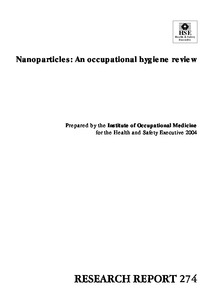Nanoparticles: an occupational hygiene review
"Nanoparticles are the end products of a wide variety of physical, chemical and biological processes some of which are novel and radically different, others of which are quite commonplace. We have reviewed processes for the deliberate development and manufacture of nanoparticle products and hav...
| Main Authors: | , , , |
|---|---|
| Institution: | ETUI-European Trade Union Institute |
| Format: | TEXT |
| Language: | English |
| Published: |
Sudbury
2004
HSE Books |
| Subjects: | |
| Online Access: | https://www.labourline.org/KENTIKA-19138546124919567289-Nanoparticles-an-occupational-.htm |
| _version_ | 1771659899971829760 |
|---|---|
| author | UK. Health and Safety Executive Aitken, Robert J. Creely, Karen S. Tran, C.L. |
| author_facet | UK. Health and Safety Executive Aitken, Robert J. Creely, Karen S. Tran, C.L. |
| collection | Library items |
| description | "Nanoparticles are the end products of a wide variety of physical, chemical and biological processes some of which are novel and radically different, others of which are quite commonplace. We have reviewed processes for the deliberate development and manufacture of nanoparticle products and have considered sources and routes of exposure, levels of exposure, numbers exposed, knowledge gaps and future trends. We conclude that all of the four main groups of nanoparticle production processes may potentially result in exposure by inhalation, dermal or ingestion routes and that little is known about current levels of exposure. Control approaches are available which should be effective for exposure by inhalation but this has not been demonstrated. Control approaches for dermal and ingestion exposure may not be as effective as they are for larger particles. Surface area is probably the best exposure metric for some but not necessarily all nanoparticles but there are no effective methods by which this can be measured in the workplace. Current knowledge is insufficient for risk assessment purposes. The number of workers who may be exposed to nanoparticles in the university sector and in emerging nanoparticle companies may be as high as 2000. Around 100,000 individuals may potentially be exposed to fine powders through various powder handling processes. It is not possible to say what proportion of these may be exposed to nanoparticles although it is likely to grow. More that 1,000,000 workers in the UK may be exposed to nanoparticles via incidental production in processes such as welding and refining. In summary, we conclude that there is little evidence to suggest that the exposure of workers arising from the production of nanoparticles has been adequately assessed. This report and the work it describes were funded by the Health and Safety Executive (HSE). Its contents, including any opinions and/or conclusions expressed, are those of the authors alone and do not necessarily reflect HSE policy."
(Authors' abstract) |
| format | TEXT |
| geographic | United Kingdom |
| id | 19138546124919567289_d779b5c5ba9043b184c37c9220dc2408 |
| institution | ETUI-European Trade Union Institute |
| is_hierarchy_id | 19138546124919567289_d779b5c5ba9043b184c37c9220dc2408 |
| is_hierarchy_title | Nanoparticles: an occupational hygiene review |
| language | English |
| physical | 102 p. Digital |
| publishDate | 2004 |
| publisher | Sudbury HSE Books |
| spellingShingle | UK. Health and Safety Executive Aitken, Robert J. Creely, Karen S. Tran, C.L. chemical analysis exposure assessment inhalation job exposure relation prediction routes of entry skin absorption nanotechnology ingestion Nanoparticles: an occupational hygiene review |
| thumbnail | https://www.labourline.org/Image_prev.jpg?Archive=113957993113 |
| title | Nanoparticles: an occupational hygiene review |
| topic | chemical analysis exposure assessment inhalation job exposure relation prediction routes of entry skin absorption nanotechnology ingestion |
| url | https://www.labourline.org/KENTIKA-19138546124919567289-Nanoparticles-an-occupational-.htm |

